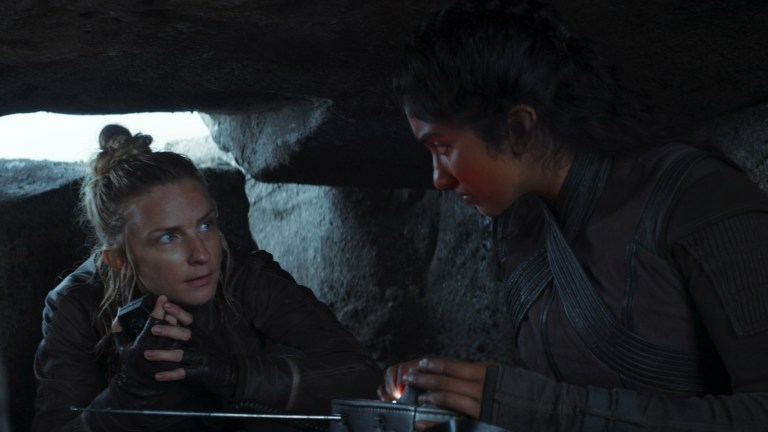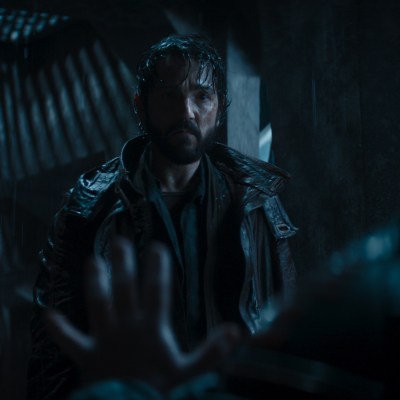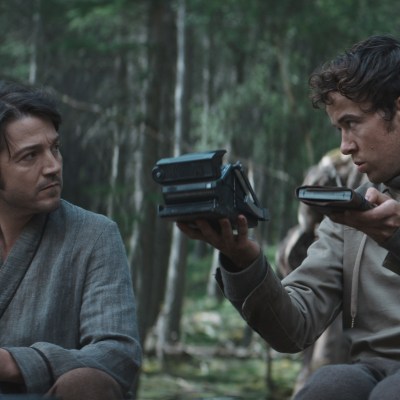Star Wars: Andor Episode 6 Review – The Eye Gets One Major Twist Wrong
The first major character deaths in Andor seem to change everything, but is it for the better?

This Star Wars: Andor review contains spoilers.
Andor Episode 6
Throughout most of Star Wars: Andor episode 6, “The Eye,” you’re constantly expecting the heist of the Imperial payroll on the planet Aldhani to go horribly wrong. Interestingly enough, most of the Rebel operation goes according to plan. Our insurgents do escape with the money, and thankfully, they don’t resort to killing the family of the Imperial commandant, or any innocent civilians. But, by the end of this episode, three of these Rebels will be dead, and not for the reasons that you think. With episode 6, Andor has picked up the pace, slightly, and brings with it a broader message: Nobody is safe.
Although Andor is the most trope-busting Star Wars product ever, episode 6 is still filled with plenty of nods to other classic sci-fi beats. We get a beautiful celestial event that only occurs once in a few years, combined with some fairly generic local religious pilgrims who view this spectacular moment as sacred. This local color turns out to be literal local color, because during the climactic escape from the Imperial base, as TIE fighters are chasing Cassian and the gang, the bright green-blue sky creates a stark contrast to the muted shading of the rest of this (and the previous) episode. Visually, aesthetic decisions have a long history of influencing the overall story of Star Wars, but with this episode, it’s almost as if the burst of color at the end signals something else: This part of the story is over, here’s the splash of color to prove it.
In fact, if you’re on the fence about the pacing of Andor, the sequence of events in this episode seems determined to convince you that everything is now different. Former stormtrooper turned Rebel Taramyn (Gershwyn Eustache Jr.) is killed during the heist, a death that feels perfunctory, and from a plot point of view, oddly unnecessary considering what happens next. As Cassian takes the stolen ship up into the sky, a bunch of the cargo smashes into Nemik (Alex Lawther), which later, even after the gang takes him to a four-armed doctor, ends up meaning his death, too.
While Nemik is being operated on (in vain) Skeen (Ebon Moss-Bachrach) suggests to Andor that they steal the 80 million credits from the Rebels they’ve been helping and split it 50-50. Skeen reveals his sob story from the previous episode was bogus, and he’s only interested in stealing the money. But instead of turning Skeen over to Vel (Faye Marsay), Cassian blasts him and then uses his original cut of 30,000 credits to take the doctor’s ship. Both Skeen and Cassian wanted to walk away after the job was done, but the difference is that Cassian’s price was much lower.
This decision plays with how much we like and trust our lead character. Presumably, Cassian could have demanded his cut and freedom from Vel without killing Skeen. But the writing sort of twists us into feeling like this is the only way all of this could have gone down. The storytelling style of Andor isn’t ruminative while you’re watching it. Instead, it’s aggressively quotidian. Every minor move is depicted, even if it’s just a moment where someone is struggling to put on their belt. Again, as with the rest of the series, all of these moments of commonplace reality are somewhat new to Star Wars, which makes some of the more conventional storytelling in “The Eye” feel somewhat jarring.
Even if Rogue One didn’t exist, it would be obvious that Cassian isn’t really going to ditch the Rebel Alliance forever. After young Nemik dies, Vel gives Cassian his “manifesto,” which is clearly meant to set up a moment in a future episode where Cassian either reads it and looks sad or doesn’t read it and looks sad. Either way, the death of Nemik feels like part of the plot mechanism which will swing Cassian over to the Rebel side once more. (Yay?)
Considering how realistic Andor has been up until this point, this feels a little like a cheap move. Does Cassian really have to feel like joining an idealistic cause because of the death of a naïve young person? Why didn’t the death of the perfectly noble grown man Taramyn move him to a similar simmering epiphany?
When fans and scholars unpack other Star Wars plot structures, outside of Andor, there tends to be a focus on the plot just being a given and the character’s choices somewhat predetermined. Much of this predictable hero’s journey structure is, arguably, what has prevented Star Wars from having much narrative diversity. The promise of Andor was that all of those old storytelling traditions would be thrown out for something more real. In the end, the death of Nemik could turn out to be a totally convincing, utterly moving catalyst for profound change within the character of Cassian Andor. However, right now, in this episode, it feels like an arbitrary plot choice, something that basically works but is still a little corny. You get the sense that these characters weren’t killed by falling cargo or laser blasts at all but rather by the writers. If Cassian needs to go do something else on his long journey, then some of these other characters just have to die.
As a series at its halfway point, Andor seems to be building toward a greater journey for its lead character. It’s just that, at this point, it’s not clear what that journey is or what it means. And, in fairness, that might be the entire point.


